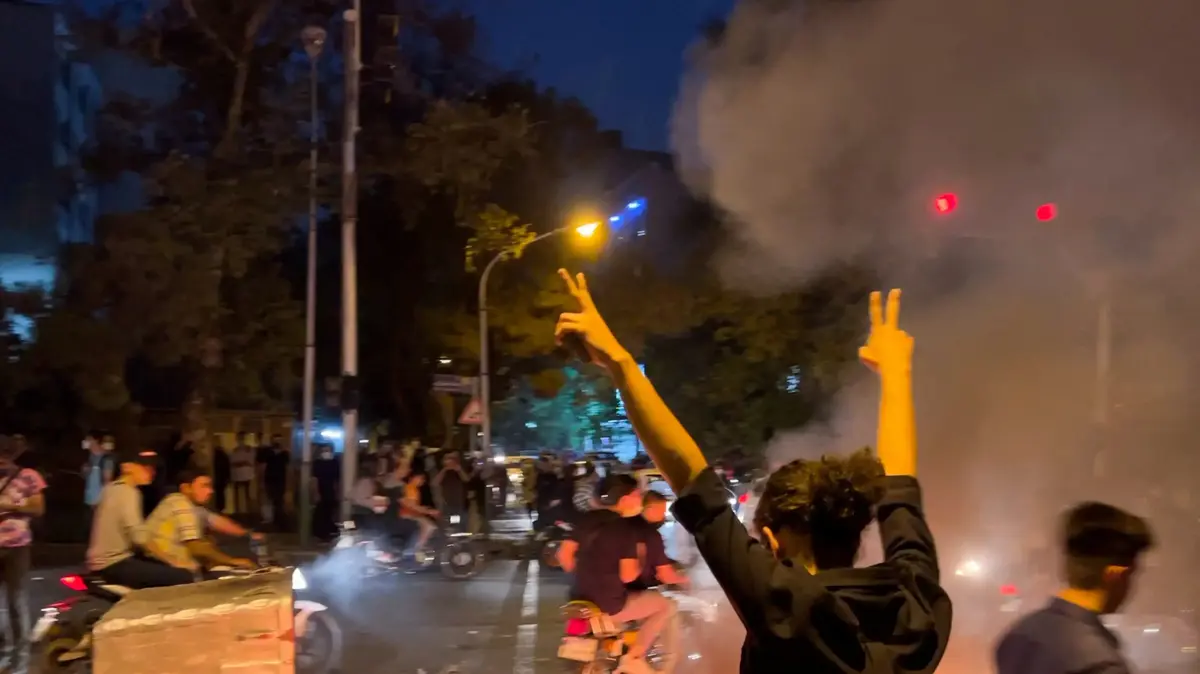Arrests, torture, deaths: the protests in Iran and the bloody response of the mullahs' regime
Created: 11/17/2022, 2:38 p.m
By: Luisa Billmayer
For more than seven weeks, women and men have been protesting against the oppressive mullahs' regime in Iran.
© dpa/N.
Bruckmann/M.
Litzka (assembly)
Courageous Iranians have been fighting back against the religious ruler Ali Khamenei and President Ebrahim Raisi every day for around two months.
Our maps and analysis show the government's brutal response.
The strict rules and laws of the mullahs' regime characterize public and private life in Iran.
Dancing in the street as a woman?
Forbidden.
Reporting critically about the regime?
Can cost journalists their freedom.
Has the hijab slipped in the eyes of the Gasht-e Ershad vice squad?
Better not.
Our analysis of current data from the protest shows the consequences for the demonstrators in this society.
Jina Mahsa Amini apparently lost his life for not wearing the headscarf correctly.
The Gascht-e Erschad arrested the 22-year-old Kurd on September 13, 2022 in Tehran - accused of "wearing inappropriate clothing".
The young woman died in police custody three days later in a hospital in Tehran.
Human rights organizations and the media report ill-treatment during and after arrest.
The police deny the allegations.
Amini's father then makes it clear that he does not accept the explanations given by the police.
Jina Mahsa Amini becomes the face of the Iranian wave of protests.
Our map shows how this has spread across the country since Amini's death.
The first demonstrations broke out on the day of Amini's funeral in Saqqez.
Especially in their home province of Kurdistan, but also in the capital Tehran.
Anger at the incident and at the regime is spreading across the country.
In the first ten days, protesters took to the streets in at least 93 cities in almost all Iranian provinces.
"Death to the dictator" and "Women, life, freedom" they shout.
Since Jina Mahsa Amini's death, protests have spread across Iran
Since then, many people have taken to the streets, especially in Amini's homeland of Kurdistan, as a data analysis of the protests shows.
In the capital, Tehran, there has also been at least one protest rally almost every day since September 29.
The Critical Threats Project (CTP) analyzes figures on the demonstrations.
Based on media reports and social media posts, the institute collects and checks where and when protests took place.
The regime's violent response costs hundreds of lives
The Iranian regime is trying to use violence to quell the protests.
"A human life in Iran is worth nothing," said Iran expert Natalie Amiri in an interview with Jung & Naiv.
The security forces arrest demonstrators, use tear gas and shoot at people in the streets.
Photos of people with small wounds on their backs are circulating on Twitter.
The wounds are said to come from shot bird shot.
also read
Rocket hit in Poland: Russia blames the West – Kremlin representative points to 2014
Explosion, assassination, accident: Russian Cherson officials disappear - who is behind it?
Almost 16,000 people have been arrested in the past few weeks, reports the human rights organization Human Rights Activists In Iran.
The detainees face torture and, in the worst case, the death penalty.
Iranian security forces have killed at least 342 demonstrators in the streets since September 17, reports Iran Human Rights.
There were particularly many fatalities in and around Kurdistan and near the capital Tehran.
But with 123 people so far, the provinces of Sistan and Balochistan have by far the most dead.
Why did so many people lose their lives there?
"The Iranian leadership fears that the escalating unrest could escalate into a more serious threat to the regime.
Therefore, it applies a higher level of repression there than in other parts of the country,” an Iran expert from the Critical Threat Project (CTP)
told IPPEN.MEDIA
.
"Bloody Friday": Security forces in Sistan and Balochistan react particularly brutally
On September 30, the so-called "Bloody Friday", dozens of people died in the provincial capital Zahedan.
Snipers, security guards and plainclothes police officers shot at people, including children, indiscriminately.
The number of deaths for this day alone varies between 66 and 96. According to the CTP, the actual number is likely to be even higher.
The population of the provinces of Sistan and Balochistan is predominantly Sunni, as are the Kurds.
The Shiite regime has therefore been discriminating against the people of Iran's poorest region for years.
In the past, repression has repeatedly led to attacks on the security forces there.
The course of the protests over the next few weeks will show whether the demonstrations will actually lead to the fall of the mullahs' regime and make room for a new social system.
Supporters of the protests see the situation as at least the beginning of a revolution.
If the uprising succeeds, Iran could see the world's first feminist revolution.
Transparency: Our data, sources and methods
The figures reported by different sources on protests that took place, people arrested and demonstrators killed vary.
However, the CTP and human rights organizations believe that the reported data is lower than the actual figures.
We included information from Iran Human Rights and Human Rights Activists In Iran.
Based on the evidence, the Critical Threats Project (CTP) divides the protests into three different categories: low, moderate and high probability.
The higher the probability, the better the evidence that a protest has taken place.
We summarize events of all categories in our map.
The CTP collects reports and concrete evidence of the protest activities since September 28 in the Iran Crisis Updates.
CTP is a project of the American Enterprise Institute with support from the Institute for the Study of War.
Reports from the AFP served as additional sources.








